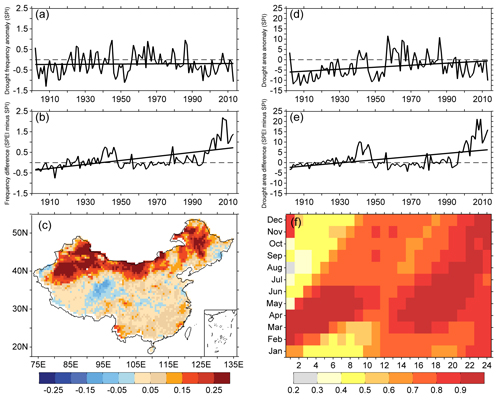Drought response to air temperature change
Date:2015-01-26
Drought in China shows greatly response to air temperature change on the centennial scale, with relatively stronger in northern China and weaker in southern China. The significantly increasing trend of drought in China based on observations only appears when considering the effects of air temperature change, which can explain ~49% of droughts in observations and 30%–65% of droughts in CMIP5 model simulations.

(a) Evolution of the regional annual drought frequency anomaly for the period 1902–2013 based on the SPI. (b) Difference between the SPEI and the SPI with respect to annual drought frequency. (c) Spatial distribution of the linear trends for the difference of annual drought frequency between the SPEI and the SPI from 1902 to 2013 (months per decade). (d, e) The corresponding evolutions of the percentages of drought areas in China as in (a, b), respectively. (f) Plots of the linear trends for the drought area difference between the SPEI and the SPI for each month at time scales of 1–24 months (% per decade). The drought frequency and area are selected based on an SPEI/SPI threshold of ?1.28 and their anomalies are estimated with respect to 1961–1990.
Citation: Chen, H.-P., and J.-Q. Sun, 2015: Drought response to air temperature change over China on the centennial scale,?Atmos. Oceanic Sci. Lett., 8, doi:10.3878/AOSL20140089.
Download: http://159.226.119.58/aosl/EN/abstract/abstract534.shtml
